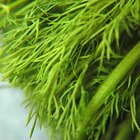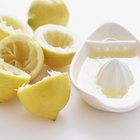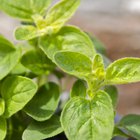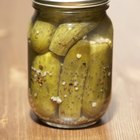merc67/iStock/GettyImages
Used primarily in the 1950s and 1960s as a firming agent for pickles, alum has fallen out of favor as health concerns regarding aluminum in the diet have risen. There are several natural substitutes for alum that do not impart the strong astringent taste of this now seldom-used ingredient, while still keeping pickles firm and crisp throughout storage. Follow a reliable recipe and use horseradish, various leaves or food-grade lime to avoid soft pickles each season.
Pickling Basics
Pickling is achieved two ways. One is through fermentation, where yeasts and bacteria are allowed to populate your brined vegetables and create acid to preserve them. The other way is a quick pickle that is made by using a vinegar solution to preserve the pickles. Over time, both promote the softening of pickles, and therefore require a firming agent to help keep pickles crisp. Alum is very effective in keeping pickles firm, more so even than most alternatives, but is rarely used outside of commercial production due to health concerns about aluminum in the diet.
Various Leaves
There are several types of leaves used to help keep both fermented and fresh pickles crisp. Oak leaves, sour cherry leaves and grape leaves are commonly used in different parts of the world. In fresh pickling, place one or two washed leaves at the bottom of each jar. For fermented pickles, line the bottom of your crock with leaves and top the pickles with more leaves for the best results.
Horseradish
Horseradish has traditionally been used as a pickle flavoring and is also known to help prevent softening. It is most suitable for fermented pickles where its biting flavor mellows throughout the fermentation process. For inclusion in a fermented pickle recipe, chop or grate the horseradish before adding it to the pickling crock. In fresh pickles, it is best to avoid this firming agent unless you particularly enjoy its strong mustardy flavor.
Lime
Lime is traditionally used as a firming agent in Southern pickle recipes for cucumber, melons and green tomatoes. Made of calcium oxide, the lime absorbs into the tissues of vegetables or fruit and combines with their pectin to form the calcium pectate that keeps pickles firm. Food-grade lime can be found in a preserving store or pharmacy, or ordered from an online source. It is important to soak and then rinse your fruit or vegetables three times when using lime; lime raises your pickle's pH and should only be used in recipes where it is specifically called for.
Related Articles
Why Do We Soak Cucumbers in Water ...

Classic Russian Spices

About Fresh Ginger Substitutes
How to Pickle Without Vinegar

How to Ferment Beets

Why Does Lemon Juice Stop Apples From ...

A Substitute for Japanese Parsley

Are Pickled Vegetables Allowed on a Raw ...

How to Make Cucumber Kimchi

Herbs for Chicken Soup

How to Eat Fresh Oregano Leaves

What Are Health Benefits of Stinky Tofu?

How to Keep Peeled Vegetables From ...

Preservatives in Campbell's Soups

What Are the Seeds in Pickle Jars?

How to Cook Raw Tuna in Lemon

Foods That Are Natural Antibiotics

What Makes Pico de Gallo Taste Bitter?

Baking With Juice Concentrates

How to Buy and Use Capers in Cooking
References
- The Joy of Pickling; Linda Ziedrich
Writer Bio
Based in Portland, Ore., Maxine Wallace is a writer with more than 12 years of experience. With a bachelor's degree in journalism and experience working on marketing campaigns for large media agencies, she is well-versed in multiple industries including the Internet, cooking, gardening, health, fitness, travel and holistic living.